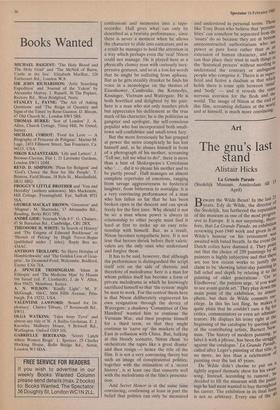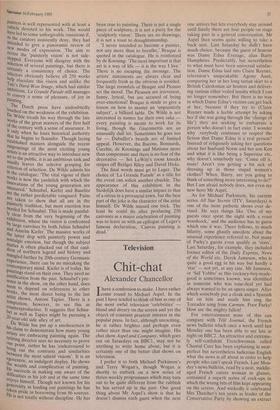Art
The gnu's last stand
Alistair Hicks
La Grande Parade (Stedelijk Museum, Amsterdam till 15 April) Beware the Wilde Beast! In the last 21, years, Edy de Wilde, the director °I the Stedelijk, has furthered the reputation of the museum as one of the most progres. sive in Europe. It is not surprising, there- fore, that La Grande Parade, an exhibitiou reviewing post-1940 work and given in tie Wilde's honour on his retirement Was awaited with bated breath. In the event the t Dutch critics have damned it. They P°i20 out that the choice of 250 paintings by painters is highly subjective and that there are too few recent works to justify t!„e claim to be 'showing latter-day painting,'" full relief and depth by relating it to toe painting of older generations'. 'Go tnt Eindhoven', the patriots urge, 'if you wane to see avant-garde art.' They play clown the main point of the exhibition, its atmos- phere, but then de Wilde commits sue, rilege. In this his last fling, he makes it quite plain that he couldn't care a fig Or critics, commentators or even art admints. trators. He displays his irony right at the beginning of the catalogue by quoting one of the contributing artists, Barnett Nevi- man. The history of modern painting, to label it with a phrase, has been the struggl,e against the catalogue.' La Grande Partici!' called after Leger's painting of that title, Is, no more, no less than a celebration °` painting over the last 45 years. De Wilde didn't choose to put on a tightly argued thematic show for his swan' song. Instead, according to rumour,be decided to fill the museum with the paint' ings he had most wanted to buy throughout his career. The exhibition in its final 0111,1 is not so arbitrary. Every one of the 40 Painters is well represented with at least a cubicle devoted to his work. This would have led to some unforgivable omissions if, as the curators insistently deny, they had intended to give a panoramic review of new modes of expression. The aim to revere the 'painterly vision' is not side- stepped. Everyone will disagree with the selection of several paintings, but there is certainly a consistency of choice. The selectors obviously believe all 250 works help elucidate this vision and unlike the Tate's Hard-Won Image, which had similar ambitions, La Grande Parade still manages to convey a sense of pleasure, of joy in
Painting. The Dutch press have undoubtedly touched on the weakness of the exhibition. De Wilde treads his way through the late Works of the great masters of the first half of the century with a sense of assurance. It
is only when he loses historical authority that he begins to flounder. Though laying established masters alongside the recent outpourings of the most exciting young artists is an attractive way to introduce new
art to the public, it is an ambitious task and usually leaves the selector grasping for criterion of selection. De Wilde admits his
in the catalogue: 'The vital vigour of their works is now the yardstick with which the innovations of the young generation are
Measured.' Schnabel, Kiefer and Baselitz are the rather predictable vanguard. Pains are taken to show that all are in the Painterly tradition, but most exertion was needed for Schnabel. This is made painful- ly clear from the very beginning of the
exhibition, where the visitor is confronted by large canvases by both Julian Schnabel and Anselm Kiefer. The massive works of
the latter drip with painterly power and nostalgic emotion, but though the subject Matter is often plucked out of that caul- dron of northern legend and history and.
mangled further by 20th-century Germanic experience, there can be no mistaking the contemporary mind. Kiefer is of today, his Paintings stand on their own. They need no justification from the past. Schnabel's pre-
sence in the show, on the other hand, does
seem to depend on references to other works, the most direct being to the last artist shown, Antoni Tapies. There is a temptation, however, to see this as counterproductive. It suggests that Schna- bel as well as Tapies might be pursuing a 4-year-old side alley of art. L. De Wilde has put up a smokescreen in ms claim to demonstrate how many young artists are embracing painting again. The retiring director sees no necessity to prove °Lite point, rather he has 'endeavoured to "ring out the contrasts and similarities between the most salient visions'. It is an egocentric, an indulgent display. He shows the wealth and complication of painting.
He succeeds in making one aware of the difficulties in his job and at the same time enjoys himself. Though not known for his generosity in lending out paintings he has taken pride in borrowing from 86 sources. He is not totally without discipline. He has been true to painting. There is not a single piece of sculpture; it is not a party for the `sculptorly vision'. There are no drawings; it is not a toast to draughtsmanship.
`I never intended to become a painter, not any more than to breathe,' Braque is quoted in the catalogue. He is reinforced by de Kooning: 'The most important is that art is a way of life — it is the way I live.' There is no escaping the message. The artists' statements are always clear and frequently fresh as the obvious is avoided. The large roomfuls of Braque and Picasso set the mood. The Picassos are irreverent, funny, lyrical, but are accused of being over-emotional! Braque is made to give a lesson on how to master an 'unpainterly subject', a billiard table. De Wilde is not interested in names for their own sake every_ painting is meant to work for its living, though the Giacomettis are an unusually dull lot. Sometimes he goes too far — Dubuffet's beards are of limited appeal. However, the Bacons, Bonnards, Cucchis, de Koonings and Matisses more than compensate and there is no fear of the decorative — Sol LeWitt's room knocks stripes off Bridget Riley and David Hicks. The final words must go to Leger. The choice of `La Grande Parade' as a title for the event can solicit another chuckle. The appearance of this exhibition in the Stedelijk does have a similar impact to that of a circus in a provincial town, but the best part of the joke is the character of the artist himself. De Wilde missed one trick. The least he could do after producing 250 canvases as a major celebration of painting was to leave us with an epilogue of Leger's famous declaration, 'Canvas painting is dead.'















































 Previous page
Previous page